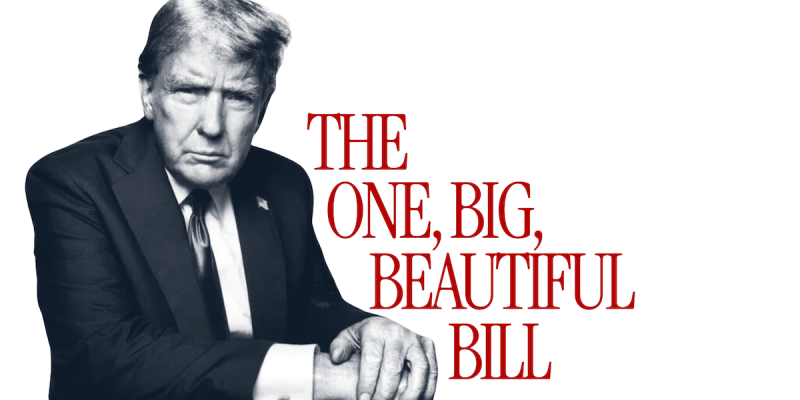Donald Trump’s recently unveiled One Big Beautiful Bill (OBBB)—a sprawling legislative proposal that merges tax cuts, immigration crackdowns, fossil fuel incentives, and border enforcement—has triggered intense debate in Washington. But its implications could extend far beyond U.S. borders.
For India, the world’s most populous democracy and the largest recipient of remittances from the U.S., this bill holds high economic, strategic, and human consequences—particularly as over 2.7 million Indian-born individuals live in the U.S., many on temporary visas.
🇺🇸💸 Remittance Tax: A Direct Hit to Indian Households
At the heart of the bill is a 5% tax on all remittances sent by non-citizens, including:
- H-1B visa holders (Indian IT professionals, engineers, doctors)
- F-1 visa students (tens of thousands in U.S. universities)
- Green card holders who are not yet full U.S. citizens
📉 Economic Fallout for India
India received over $27 billion in remittances from the U.S. in 2023, according to the World Bank. A 5% tax could reduce this flow by at least $1.3–1.5 billion annually, assuming senders don’t cut back on transfers.
📌 “This is essentially a penalty on hard-working migrants who are already taxed in the U.S. and are now being taxed again for supporting their families back home,” said a former Indian ambassador to the U.S.
🧾 Example:
An Indian tech worker earning $100,000/year on an H-1B visa who sends $1,500/month to his parents in Pune would now face an extra $75/month in taxes—almost ₹75,000 per year, just to remit.
🧳 Harsher Immigration Rules: Visa Hurdles for Indian Talent
The bill proposes:
- More funding for immigration enforcement
- A clampdown on visa overstays and asylum loopholes
- Possible changes to work permits and family migration pathways
While not specific to H-1B or F-1 visas, the climate becomes tougher for all migrants, creating longer processing times, added legal risks, and uncertainty for:
- Indian STEM graduates looking to transition from OPT to H-1B
- Indian professionals seeking green cards, already facing multi-year backlogs
- Dependents and spouses of visa holders
👩💻 “Indian IT firms and startups will be forced to rethink their U.S. hiring plans if skilled migration becomes more complex,” said a Nasscom executive.
🌍 Climate & Energy Trade: Clean Tech Setback for India
The OBBB eliminates:
- Electric vehicle (EV) tax credits
- Federal solar energy subsidies
- Clean energy grants and research funding
This is a setback for India’s green technology exports, especially for:
- Solar panel manufacturers in Gujarat and Tamil Nadu
- EV battery makers in Maharashtra
- Indian firms in clean hydrogen and wind tech looking for U.S. partnerships
🌱 “It could cool off the momentum around India–U.S. climate collaboration under the Biden administration’s Build Back Better World initiative,” said an official at India’s Ministry of Power.
🛡️ Defence & Strategic Ties: Some Upside for India
The bill includes massive increases in U.S. defence spending, with a strong emphasis on the Indo-Pacific and countering China. This aligns well with India’s strategic goals.
📌 Possible Gains:
- Co-development of military technology under DTTI (Defense Technology & Trade Initiative)
- More joint exercises in the Indian Ocean Region (e.g., MALABAR naval drills)
- Accelerated purchase of U.S. drones, submarines, and surveillance aircraft
🇮🇳 “Defence is one area where bipartisan alignment between India and the U.S. is strong, irrespective of who wins the U.S. elections,” said Lt. Gen. (retd) D.S. Hooda.
📉 Macro Risks: Currency, Markets, and Investment
Critics of the bill warn of its $3–4 trillion projected addition to the U.S. federal deficit. If this leads to:
- Higher U.S. bond yields
- A stronger U.S. dollar
- More aggressive Federal Reserve action
Then emerging markets like India could see:
- Rupee depreciation against the dollar
- FII outflows from Indian equities and debt
- Higher costs of imported oil and gas
📊 “Even a 1% hike in U.S. interest rates tends to trigger a 5–8% correction in Indian equities,” said a Mumbai-based portfolio manager.
🇮🇳 What India Must Do Now
| Policy Domain | India’s Strategic Response |
|---|---|
| Remittance flows | Strengthen bilateral lobbying through MEA & RBI |
| Skilled migration | Negotiate bilateral visa carve-outs (e.g., U.K.-style pact) |
| Climate cooperation | Deepen ties with EU, UAE, and Japan for green finance |
| Defence cooperation | Push for more tech-sharing, drone and naval systems |
| Market risk buffers | Strengthen rupee reserves, deepen local capital markets |
🧠 Bottom Line
The One Big Beautiful Bill may be a U.S. domestic political project, but for India, its effects will be tangible. From family incomes in small towns to trade corridors, startup plans, and capital flows, the consequences of this bill—if passed—could shape the trajectory of India’s next decade.
While the bill’s future in Congress remains uncertain, India cannot afford to wait and watch.














Comments